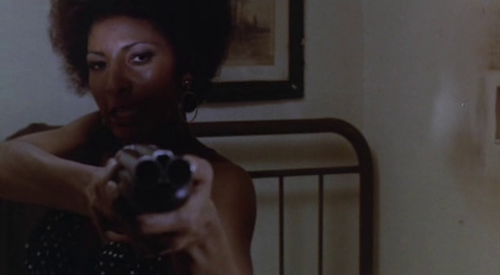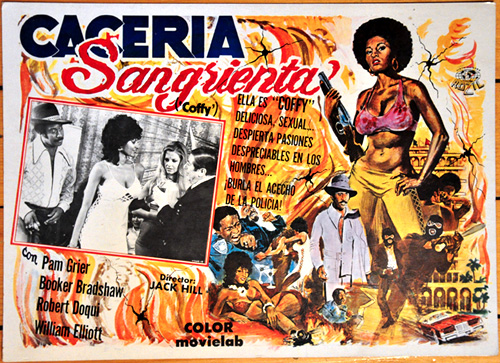In celebration of black excellence during this month of history, let's talk about some blaxploitation films. You dig?
First up is one of my favorites, a classic of the genre, Coffy, a 1973 revenge film starring genre icon Pam Grier as a vigilante "one-woman hit-squad" out for justice against the pimps and the drug pushers. As one of the many ingenious taglines phrases it, "No one sleeps when they mess with Coffy!"
Why is Coffy out for revenge? Well, it seems some drug dealer types got her little sister hooked on heroin, landing her in a rehabilitation home. Coffy is no stranger to what the drug trade and mobsters are doing to the community, as she has experience treating victims of violence at her day job at a local hospital where she's a nurse. She tries to confide in a former boyfriend Carter (William Elliot), a straight and by-the-book cop, who is facing his own battles with corruption on the police force, but after Carter is severely beaten in his home by a couple of mob thugs, Coffy's resolve for vengeance is fortified even further.
Coffy finds momentary comfort with her current boyfriend, Howard Brunswick (Booker Bradshaw), a city council member considering running for Congress. He's a socially conscious politician who seemingly wants the best for the community. He also seemingly loves Coffy, and she seems to love him. She is at her most feminine and vulnerable with him, but she doesn't tell him what she's done or what she plans to do. Which is maybe a good thing, as she plans on infiltrating a prostitute ring in an effort to further her vengeance. Even the most understanding boyfriend might have trouble with that one.
This prostitute ring is ran by a pimp named King George (Robert DoQui), one of the cities largest providers of illicit flesh and illegal substances, who is working for a mafia boss named Arturo Vitroni (Allan Arbus). Coffy decides to pose as a prostitute, first gaining insight into what kind of women King George likes by questioning Priscilla (Carol Locatell), a former patient of hers (and prostitute of theirs). Coffy slaps the shit out of this lady, threatening her with a broken bottle, showing little remorse as Priscilla has obviously lapsed back into drug abuse. This scene provides one of the more comedic moments of the film though, as Priscilla's "old man" Harriet shows up and starts smashing chairs and threatening Coffy.
King George takes an instant liking to Coffy (pretending to be a Jamaican named Mystique). He brings her back to his house, but the other girls don't seem to appreciate the sudden intrusion, especially Meg (Linda Haynes), who seems to be the King's #1 lady. Later at a party thrown for Vitroni, Meg purposefully knocks some drinks onto Coffy, which of course leads to an all out female brawl. Like all good catfights, hair is pulled, faces are slapped, and tops are ripped off. Coffy goes the extra mile, having hid razors in her afro, which slice up Meg's hands when she goes to rip her hair. King George and Vitroni are both impressed, as they should be. It's one of the best scenes in the movie.
Left alone with Vitroni (who is a sadistic racist), Coffy attempts to shoot him, but is stopped by Omar (Sid Haig), one of his vicious thugs. In an effort to pit them against one anther, she lies to Vitroni and says that King George hired her to murder him. The mob being the understanding guys that they are, they then take King George for a ride before throwing a noose around his neck (!) and dragging him through the streets behind a Cadillac. It's one of the more viscous and racially charged scenes in the movie.
As time runs out on Coffy, she is captured, locked up, and faced with the truth of how deep corruption runs in her city. The bad guys count her out, but when she breaks out, all hell breaks loose.
Released in 1973, during the boom in blaxploitation pictures, Coffy was unique, not only for its anti-drug message, but in that it starred a woman as the central hero. Her vengeance is both personal and societal, she fights for her sister and her community at large. Neither a criminal (at least prior to her murder spree) nor a victim, Coffy is an independent woman who is smart, strong, and resourceful, all in addition to being drop dead sexy. Her look is iconic, big afro and alluring curves. Grier does a good job carrying the movie (she's in almost every scene), even though some of her acting is raw. She does occasionally display her natural and very likable personality, although not as often as she bares her natural and very likable breasts. (I'm not complaining, I just have to say it.)
Pam Grier would get her start with a small role in Beyond the Valley of the Dolls in 1970. Director/writer Jack Hill instantly recognized that she would be a star and cast her in slightly larger, but still supporting roles in both The Big Doll House (1971) and The Big Bird Cage (1972), two "women in prison" films. Hill would write the role of Coffy specifically for Grier, and the movie would go on to be a great financial success (audiences loved it too). Grier would go on to be one of the top stars of the blaxploitation genre, starring in Hill's follow-up, Foxy Brown in 1974, as well as Scream, Blacula, Scream (1973), Sheba Baby, Bucktown, and Friday Foster (all 1975). As the genre would dry up after the '70s, Grier would make memorable appearances in Ray Bradbury's Something Wicked This Way Comes (1983), Above the Law (1988), Class of 1999 (1990), and Escape from L.A. (1996). She would make what is considered her best picture in 1997, Quentin Tarantino's Jackie Brown, itself a partial homage to blaxploitation films, as well as being a role that was written specifically for Grier.
Director Jack Hill is one of the best directors of exploitation pictures, displaying economy, excitement, and variety in his storytelling, something that stood out on the exploitation circuit. He would get his start working for Roger Corman, doing uncredited work on films like The Wasp Woman (1960) and The Terror (1963, parts of which were used for Targets), and shooting US scenes for Mexican movies like House of Evil and The Snake People (both 1971). His 1964 weird and wonderful horror film Spider Baby would go unreleased until 1968 and wouldn't gain any sort of notoriety until 25 years later. Hill would gain steady directing jobs starting in 1971, with The Big Doll House, which would be the first of 4 collaborations with Pam Grier, followed by The Big Bird Cage, Coffy, and Foxy Brown. Hill would also write and direct The Swinging Cheerleaders (1974) and Switchblade Sisters (aka: The Jezebels, 1975), which is another legitimate exploitation classic. In addition to discovering Grier and Sid Haig, Jack Hill would also discover Ellen Burstyn, future Oscar nominee and winner (The Exorcist [1973], Alice Doesn't Live Here Anymore [1974]), casting her in his 1969 racing movie, Pit Stop.
The pimp costumes that Robert DoQui wears are so flamboyantly awesome that they should go into the pimp hall of fame. DoQui would go on to star in Robert Altman's ensemble drama Nashville (1975), as well as all three Robocop movies as Sgt. Warren Reed. Alan Arbus is probably best known as the shrink that would visit the cast of the hit TV show M*A*S*H, and William Elliot would fight giant killer rabbits in Night of the Lepus (1972). Linda Haynes would play William Devane's poor wife in Rolling Thunder (1977) and Carol Locatell (credited as Lawson) would go on to play mean, old Ethel in Friday the 13th: A New Beginning (1985).
The soundtrack (by Roy Ayers) has the requisite funk and vibe of the genre, but in general it fails to reach the iconic heights of Across 110th Street (Bobby Womack), Shaft (Issac Hayes), or Super Fly (Curtis Mayfield). Cinematographer Paul Lohmann (whose energetic and efficient work on Coffy is only hampered by the poor lighting) would go on to work with Robert Altman on California Split (1974) and Nashville, as well as with Mel Brooks on Silent Movie (1976) and High Anxiety (1977), and shoot the atmospheric Charles Bronson western The White Buffalo (1977), and the scathing Joan Crawford biopic Mommy Dearest (1981). Set decorator Charles B. Pierce would go on to his own career in exploitation pictures, helming, The Legend of Boggy Creek (1972), The Town that Dreaded Sundown (1976), The Evictors (1979), and Boggy Creek II: The Legend Continues (1985; a movie so bad, it was featured on the final season of Mystery Science Theater 3000).
Coffy is a great low budget exploitation picture, fulfilling on its promise of action and sex, and a must see for fans of '70s cinema. You got to give it up for "the Godmother of them all!"
Also: I believe Coffy contains a scene with a car squealing its tires on dirt, but honestly it's a fairly murky and dark scene, so it's hard to tell definitively whether it's a dirt road or not, but I'm going to call it:
CONTAINS: Squealing Tires on Dirt





No comments:
Post a Comment